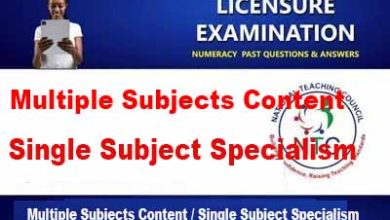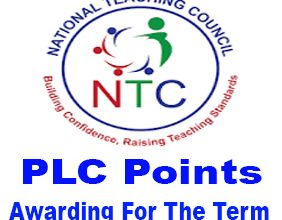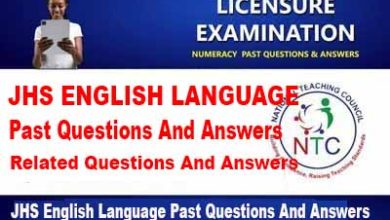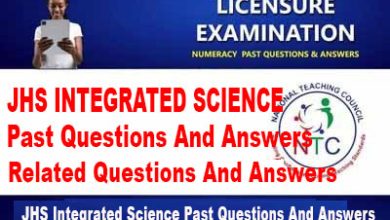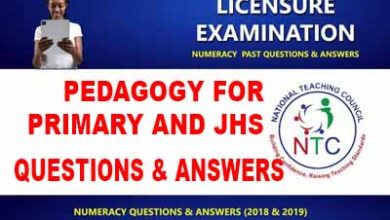NTC Licensure Exams Pedagogy For Primary And JHS Past Questions And Answers 1
GTLE Content Areas Exams Pedagogy For Primary And JHS
1. Which one of the following options is an example of a curriculum goal? To …
A. complete a certain number of tasks
B. score a certain grade on a test
C. master a certain set of skills
D. attend a certain number of classes
The correct answer is C. master a certain set of skills
2. What is the primary focus of a curriculum goal?
A. Completing a certain number of tasks
B. Scoring a certain grade on a test
C. Mastering a certain set of skills
D. Attending a certain number of classes
Answer: C. Mastering a certain set of skills
JOIN WHATSAPP HERE
NTC Licensure Exams Pedagogy For Primary And JHS Past Questions And Answers 1
NTC Licensure Exams Pedagogy For Primary And JHS Past Questions And Answers 2
NTC Licensure Exams Pedagogy For Primary And JHS Past Questions And Answers 3
NTC Licensure Exams Pedagogy For Primary And JHS Past Questions And Answers 4
NTC Licensure Exams Pedagogy For Primary And JHS Past Questions And Answers 5
NTC Licensure Exams Pedagogy For Primary And JHS Past Questions And Answers 6
NTC Licensure Exams JHS Integrated Science Past Questions And Answers
NTC Professional General Knowledge Past Questions and Answers (Literacy) 2024
NTC Professional General Knowledge Past Questions and Answers (Comprehension 1) 2024
NTC Professional General Knowledge Past Questions and Answers (Literacy) 2024
NTC Professional General Knowledge Past Questions and Answers (Comprehension) 2024
3. How are curriculum goals different from performance goals?
A. Curriculum goals are flexible, while performance goals are fixed
B. Curriculum goals focus on skills development, while performance goals focus on outcomes
C. Curriculum goals emphasize grades, while performance goals emphasize effort
D. Curriculum goals are short-term, while performance goals are long-term
Answer: B. Curriculum goals focus on skills development, while performance goals focus on outcomes
4. Which of the following is NOT an appropriate example of a curriculum goal?
A. Understanding a concept thoroughly
B. Improving problem-solving skills
C. Memorizing information for a test
D. Enhancing critical thinking abilities
Answer: C. Memorizing information for a test
5. How can curriculum goals enhance learning outcomes?
A. By encouraging rote memorization
B. By promoting surface-level understanding
C. By focusing on skill mastery and application
D. By creating unnecessary pressure on students
Answer: C. By focusing on skill mastery and application
6. What is the significance of aligning curriculum goals with instructional activities?
A. It ensures students spend more time in class
B. It guarantees high test scores
C. It helps in achieving the desired learning outcomes
D. It reduces the need for assessments
Answer: C. It helps in achieving the desired learning outcomes
7. What is the primary purpose of formative assessment in education?
A. To assign final grades to students.
B. To provide feedback during the learning process to improve instruction and student learning.
C. To rank students in a class.
D. To measure what students have learned at the end of a course.
Answer: B. To provide feedback during the learning process to improve instruction and student learning.
8. Which of the following is a characteristic of a learner-centered curriculum?
A. The curriculum is standardized for all students.
B. Teachers make all decisions about what will be learned.
C. Students have a say in what and how they learn.
D. Learning outcomes are the same for each student.
Answer: C. Students have a say in what and how they learn.
JOIN WHATSAPP HERE
NTC Licensure Exams Pedagogy For Primary And JHS Past Questions And Answers 1
NTC Licensure Exams Pedagogy For Primary And JHS Past Questions And Answers 2
NTC Licensure Exams Pedagogy For Primary And JHS Past Questions And Answers 3
NTC Licensure Exams Pedagogy For Primary And JHS Past Questions And Answers 4
NTC Licensure Exams Pedagogy For Primary And JHS Past Questions And Answers 5
NTC Licensure Exams Pedagogy For Primary And JHS Past Questions And Answers 6
NTC Licensure Exams JHS Integrated Science Past Questions And Answers
NTC Professional General Knowledge Past Questions and Answers (Literacy) 2024
NTC Professional General Knowledge Past Questions and Answers (Comprehension 1) 2024
NTC Professional General Knowledge Past Questions and Answers (Literacy) 2024
NTC Professional General Knowledge Past Questions and Answers (Comprehension) 2024
9. Bloom’s Taxonomy is a framework designed to:
A. Rank students by ability.
B. Classify educational goals and objectives.
C. Standardize tests across different schools.
D. Determine the financial needs of schools.
Answer: B. Classify educational goals and objectives.
10. In differentiated instruction, the teacher:
A. Provides the same lessons to all students but at different times.
B. Uses a variety of teaching methods to reach students with different learning styles and abilities.
C. Assigns more homework to advanced students.
D. Keeps the curriculum rigid and unchanging to maintain standards.
Answer: B. Uses a variety of teaching methods to reach students with different learning styles and abilities.
11. Which of the following statements best describes a ‘spiral curriculum’?
A. Students learn about a subject in increasing depth over time.
B. The curriculum is focused on a single subject for an entire year.
C. Topics are taught once and never revisited.
D. Students specialize in subjects they are interested in, ignoring others.
Answer: A. Students learn about a subject in increasing depth over time.
12. Which teaching method focuses on presenting information in a visual and interactive way, often used for introducing new concepts?
A. Demonstration
B. Project-based
C. Lecture
D. Discussion
Answer: A. Demonstration
JOIN WHATSAPP HERE
NTC Licensure Exams Pedagogy For Primary And JHS Past Questions And Answers 1
NTC Licensure Exams Pedagogy For Primary And JHS Past Questions And Answers 2
NTC Licensure Exams Pedagogy For Primary And JHS Past Questions And Answers 3
NTC Licensure Exams Pedagogy For Primary And JHS Past Questions And Answers 4
NTC Licensure Exams Pedagogy For Primary And JHS Past Questions And Answers 5
NTC Licensure Exams Pedagogy For Primary And JHS Past Questions And Answers 6
NTC Licensure Exams JHS Integrated Science Past Questions And Answers
NTC Professional General Knowledge Past Questions and Answers (Literacy) 2024
NTC Professional General Knowledge Past Questions and Answers (Comprehension 1) 2024
NTC Professional General Knowledge Past Questions and Answers (Literacy) 2024
NTC Professional General Knowledge Past Questions and Answers (Comprehension) 2024
13. What teaching method is known for its active and collaborative nature, encouraging hands-on learning and teamwork?
A. Demonstration
B. Project-based
C. Lecture
D. Discussion
Answer: B. Project-based
14. In which teaching method do students typically play a more passive role, listening to the instructor deliver information?
A. Demonstration
B. Project-based
C. Lecture
D. Discussion
Answer: C. Lecture
15. Which teaching method fosters communication skills, critical thinking, and exploration of different viewpoints among students?
A. Demonstration
B. Project-based
C. Lecture
D. Discussion
Answer: D. Discussion
16. How does the project-based teaching method differ from traditional lecture-based instruction?
A. Project-based learning focuses on theoretical concepts only
B. Lecture-based instruction encourages hands-on application
C. Project-based learning engages students in real-world problem-solving
D. Lecture-based instruction minimizes student participation
Answer: C. Project-based learning engages students in real-world problem-solving
17. Which teaching strategy allows students to explore concepts by creating a physical or digital product?
A. Experiential Learning
B. Direct Instruction
C. Lecture Method
D. Socratic Method
Answer: A. Experiential Learning
18. What is the primary focus of the Socratic Method?
A. Delivering comprehensive lectures on a subject matter.
B. Providing detailed instructions on how to perform a task.
C. Engaging students in dialogue to encourage critical thinking and insight.
D. Showcasing experiments to the students as proof of scientific principles.
Answer: C. Engaging students in dialogue to encourage critical thinking and insight.
JOIN WHATSAPP HERE
NTC Licensure Exams Pedagogy For Primary And JHS Past Questions And Answers 1
NTC Licensure Exams Pedagogy For Primary And JHS Past Questions And Answers 2
NTC Licensure Exams Pedagogy For Primary And JHS Past Questions And Answers 3
NTC Licensure Exams Pedagogy For Primary And JHS Past Questions And Answers 4
NTC Licensure Exams Pedagogy For Primary And JHS Past Questions And Answers 5
NTC Licensure Exams Pedagogy For Primary And JHS Past Questions And Answers 6
NTC Licensure Exams JHS Integrated Science Past Questions And Answers
NTC Professional General Knowledge Past Questions and Answers (Literacy) 2024
NTC Professional General Knowledge Past Questions and Answers (Comprehension 1) 2024
NTC Professional General Knowledge Past Questions and Answers (Literacy) 2024
NTC Professional General Knowledge Past Questions and Answers (Comprehension) 2024
19. Flipped Classroom is a teaching strategy that:
A. Requires students to switch classes daily.
B. Involves students teaching the class in place of the teacher.
C. Has students learn new content at home and apply what they learn in class.
D. Focuses exclusively on homework assignments.
Answer: C. Has students learn new content at home and apply what they learn in class.
20. Inquiry-based learning primarily focuses on:
A. Encouraging students to learn from textbooks.
B. Empowering students to search for, and use resources, to learn concepts on their own.
C. Ensuring students listen to podcasts as their main source of information.
D. Applying traditional exam-based assessment methods.
Answer: B. Empowering students to search for, and use resources, to learn concepts on their own.
21. Which approach emphasizes learning through participation in a community?
A. Cognitive Apprenticeship
B. Community of Practice
C. Lecture
D. Direct Instruction
Answer: B. Community of Practice
22. Which teaching method involves actively showing students how to perform a task or experiment rather than just explaining it verbally?
A. Lecture
B. Demonstration
C. Inquiry-based
D. Discussion
Answer: B. Demonstration
23. What is the primary focus of inquiry-based learning?
A. Passive consumption of information
B. Hands-on experimentation and exploration
C. One-way communication from teacher to student
D. Memorization of facts and figures
Answer: B. Hands-on experimentation and exploration
24. In which teaching method do students take on a more active role in their learning by posing questions, conducting investigations, and drawing conclusions?
A. Lecture
B. Demonstration
C. Inquiry-based
D. Discussion
Answer: C. Inquiry-based
25. Which teaching method is characterized by open-ended questions, critical thinking, and problem-solving activities?
A. Lecture
B. Demonstration
C. Inquiry-based
D. Discussion
Answer: C. Inquiry-based
JOIN WHATSAPP HERE
NTC Licensure Exams Pedagogy For Primary And JHS Past Questions And Answers 1
NTC Licensure Exams Pedagogy For Primary And JHS Past Questions And Answers 2
NTC Licensure Exams Pedagogy For Primary And JHS Past Questions And Answers 3
NTC Licensure Exams Pedagogy For Primary And JHS Past Questions And Answers 4
NTC Licensure Exams Pedagogy For Primary And JHS Past Questions And Answers 5
NTC Licensure Exams Pedagogy For Primary And JHS Past Questions And Answers 6
NTC Licensure Exams JHS Integrated Science Past Questions And Answers
NTC Professional General Knowledge Past Questions and Answers (Literacy) 2024
NTC Professional General Knowledge Past Questions and Answers (Comprehension 1) 2024
NTC Professional General Knowledge Past Questions and Answers (Literacy) 2024
NTC Professional General Knowledge Past Questions and Answers (Comprehension) 2024
26. How does a hands-on teaching approach benefit students compared to traditional lecture-based methods?
A. Encourages passive learning
B. Limits student engagement
C. Enhances retention and understanding of concepts
D. Reduces student participation
Answer: C. Enhances retention and understanding of concepts
27. Which of the following emphasizes direct engagement in the learning process through activities and experiences?
A. Passive Learning
B. Active Learning
C. Rote Learning
D. Indirect Learning
Answer: B. Active Learning
28. Which teaching strategy involves students working together to solve problems or achieve a common goal?
A. Independent Study
B. Collaborative Learning
C. Lecture Method
D. Authoritative Teaching
Answer: B. Collaborative Learning
29. A method that involves learning by doing, where students are encouraged to engage physically with materials rather than observing, is known as:
A. Experiential Learning
B. Direct Instruction
C. Passive Observation
D. Traditional Learning
Answer: A. Experiential Learning
JOIN WHATSAPP HERE
NTC Licensure Exams Pedagogy For Primary And JHS Past Questions And Answers 1
NTC Licensure Exams Pedagogy For Primary And JHS Past Questions And Answers 2
NTC Licensure Exams Pedagogy For Primary And JHS Past Questions And Answers 3
NTC Licensure Exams Pedagogy For Primary And JHS Past Questions And Answers 4
NTC Licensure Exams Pedagogy For Primary And JHS Past Questions And Answers 5
NTC Licensure Exams Pedagogy For Primary And JHS Past Questions And Answers 6
NTC Licensure Exams JHS Integrated Science Past Questions And Answers
NTC Professional General Knowledge Past Questions and Answers (Literacy) 2024
NTC Professional General Knowledge Past Questions and Answers (Comprehension 1) 2024
NTC Professional General Knowledge Past Questions and Answers (Literacy) 2024
NTC Professional General Knowledge Past Questions and Answers (Comprehension) 2024
30. Project-Based Learning can best be described as:
A. A method where students passively listen to lectures and memorize information for tests.
B. Students learning through the completion of projects that are often complex, engaging, and related to real-world problems.
C. A method focusing solely on reading from textbooks without practical application.
D. An approach where learning is driven entirely by teacher-led discussions.
Answer: B. Students learning through the completion of projects that are often complex, engaging, and related to real-world problems.
31. Which method incorporates posing a series of questions to students in order to promote a deeper understanding and reflection on the subject matter?
A. The Lecture Method
B. The Flipped Classroom
C. The Socratic Method
D. Direct Instruction
Answer: C. The Socratic Method
32. An example of a hands-on teaching method is …
A. Lecture
B. Demonstration
C. Inquiry-based
D. Discussion
The correct answer is B. Demonstration
33. What is the primary goal of differentiated instruction?
A. Providing the same material to all students
B. Adapting teaching methods to meet the diverse needs of students
C. Exclusively focusing on high-achieving students
D. Standardizing assessment practices
Answer: B. Adapting teaching methods to meet the diverse needs of students
JOIN WHATSAPP HERE
NTC Licensure Exams Pedagogy For Primary And JHS Past Questions And Answers 1
NTC Licensure Exams Pedagogy For Primary And JHS Past Questions And Answers 2
NTC Licensure Exams Pedagogy For Primary And JHS Past Questions And Answers 3
NTC Licensure Exams Pedagogy For Primary And JHS Past Questions And Answers 4
NTC Licensure Exams Pedagogy For Primary And JHS Past Questions And Answers 5
NTC Licensure Exams Pedagogy For Primary And JHS Past Questions And Answers 6
NTC Licensure Exams JHS Integrated Science Past Questions And Answers
NTC Professional General Knowledge Past Questions and Answers (Literacy) 2024
NTC Professional General Knowledge Past Questions and Answers (Comprehension 1) 2024
NTC Professional General Knowledge Past Questions and Answers (Literacy) 2024
NTC Professional General Knowledge Past Questions and Answers (Comprehension) 2024
34. Which of the following is a key principle of differentiated instruction?
A. Tailoring instruction to fit only one learning style
B. Using a single approach for teaching all concepts
C. Ignoring students’ readiness levels
D. Adjusting content, process, and products based on student needs
Answer: D. Adjusting content, process, and products based on student needs
35. How does flexible grouping support differentiated instruction?
A. By assigning the same tasks to all students
B. By placing students in fixed ability groups
C. By allowing for students to work with different peers based on the task
D. By promoting competition among students
Answer: C. By allowing for students to work with different peers based on the task
36. What does tiered instruction involve?
A. Providing the same assignments to all students
B. Offering varying levels of tasks based on student readiness
C. Using a one-size-fits-all approach to teaching
D. Focusing solely on high-achieving students
Answer: B. Offering varying levels of tasks based on student readiness
37. Why is curriculum compacting considered a strategy for differentiated instruction?
A. It provides standardized assignments for all students
B. It enables students to skip assignments they find easy and move on to more challenging tasks
C. It eliminates the need for individualized learning plans
D. It focuses solely on students’ weaknesses
Answer: B. It enables students to skip assignments they find easy and move on to more challenging tasks
JOIN WHATSAPP HERE
NTC Licensure Exams Pedagogy For Primary And JHS Past Questions And Answers 1
NTC Licensure Exams Pedagogy For Primary And JHS Past Questions And Answers 2
NTC Licensure Exams Pedagogy For Primary And JHS Past Questions And Answers 3
NTC Licensure Exams Pedagogy For Primary And JHS Past Questions And Answers 4
NTC Licensure Exams Pedagogy For Primary And JHS Past Questions And Answers 5
NTC Licensure Exams Pedagogy For Primary And JHS Past Questions And Answers 6
NTC Licensure Exams JHS Integrated Science Past Questions And Answers
NTC Professional General Knowledge Past Questions and Answers (Literacy) 2024
NTC Professional General Knowledge Past Questions and Answers (Comprehension 1) 2024
NTC Professional General Knowledge Past Questions and Answers (Literacy) 2024
NTC Professional General Knowledge Past Questions and Answers (Comprehension) 2024
38. What is the primary goal of differentiated instruction?
A. To ensure all students are given the same assignments and assessments.
B. To make learning accessible and effective for students with different abilities, interests, and learning styles.
C. To deliver lessons in a lecture format only, regardless of student needs.
D. To focus solely on advanced learners.
Answer: B. To make learning accessible and effective for students with different abilities, interests, and learning styles.
39. Differentiated instruction may involve changing which of the following?
A. The time of day classes are offered.
B. The classroom seating arrangement once a year.
C. Content, process, products, and learning environment based on student needs.
D. The school’s overall curriculum every semester.
Answer: C. Content, process, products, and learning environment based on student needs.
40. Curriculum compacting is a strategy particularly beneficial for which group of students?
A. Those who are struggling with the material.
B. Those who have already mastered the material.
C. Those who prefer not to participate in class.
D. Those who are new to the school.
Answer: B. Those who have already mastered the material.
41. Which of the following best describes tiered assignments in the context of differentiated instruction?
A. Assignments that are the same for every student, to maintain fairness.
B. Assignments that are created with different levels of difficulty, to match the varied readiness levels of students.
C. Assignments given only to tier-one students.
D. Assignments that change depending on the time of day.
Answer: B. Assignments that are created with different levels of difficulty, to match the varied readiness levels of students.
42. In the context of differentiated instruction, what does flexible grouping allow?
A. Students to remain with the same peers all year for every subject, to promote consistency.
B. Students to be regrouped as needed based on the subject matter, project, or their evolving needs and interests.
C. Teachers to assign students to groups based on their friends.
D. Group assignments to be decided by parents.
Answer: B. Students to be regrouped as needed based on the subject matter, project, or their evolving needs and interests.
JOIN WHATSAPP HERE
NTC Licensure Exams Pedagogy For Primary And JHS Past Questions And Answers 1
NTC Licensure Exams Pedagogy For Primary And JHS Past Questions And Answers 2
NTC Licensure Exams Pedagogy For Primary And JHS Past Questions And Answers 3
NTC Licensure Exams Pedagogy For Primary And JHS Past Questions And Answers 4
NTC Licensure Exams Pedagogy For Primary And JHS Past Questions And Answers 5
NTC Licensure Exams Pedagogy For Primary And JHS Past Questions And Answers 6
NTC Licensure Exams JHS Integrated Science Past Questions And Answers
NTC Professional General Knowledge Past Questions and Answers (Literacy) 2024
NTC Professional General Knowledge Past Questions and Answers (Comprehension 1) 2024
NTC Professional General Knowledge Past Questions and Answers (Literacy) 2024
NTC Professional General Knowledge Past Questions and Answers (Comprehension) 2024
43. Which of the following is an example of gender-neutral language?
A. ‘His or her achievements are commendable.’
B. ‘Congratulate him for his success.’
C. ‘Their achievements are commendable.’
D. ‘Congratulations to him for his success.’
Answer: C. ‘Their achievements are commendable.’
44. Why is gender-inclusive language important in educational settings?
A. It promotes discrimination.
B. It fosters a sense of belonging and inclusivity for all individuals.
C. It only benefits one gender.
D. It alienates certain groups of students.
Answer: B. It fosters a sense of belonging and inclusivity for all individuals.
45. What does it mean to use ‘singular they’ in gender-inclusive language?
A. Referring to a group of people using ‘they’ instead of ‘he’ or ‘she’.
B. Using ‘they’ as a pronoun for an individual when gender is unknown or irrelevant.
C. Referring to an individual by their last name.
D. Using ‘they’ only for formal writing.
Answer: B. Using ‘they’ as a pronoun for an individual when gender is unknown or irrelevant.
46. Which greeting is an example of gender-neutral salutation?
A. ‘Dear Sir’
B. ‘Dear Madam’
C. ‘Dear Mr. and Mrs.’
D. ‘Dear Reader’
Answer: D. ‘Dear Reader’
JOIN WHATSAPP HERE
NTC Licensure Exams Pedagogy For Primary And JHS Past Questions And Answers 1
NTC Licensure Exams Pedagogy For Primary And JHS Past Questions And Answers 2
NTC Licensure Exams Pedagogy For Primary And JHS Past Questions And Answers 3
NTC Licensure Exams Pedagogy For Primary And JHS Past Questions And Answers 4
NTC Licensure Exams Pedagogy For Primary And JHS Past Questions And Answers 5
NTC Licensure Exams Pedagogy For Primary And JHS Past Questions And Answers 6
NTC Licensure Exams JHS Integrated Science Past Questions And Answers
NTC Professional General Knowledge Past Questions and Answers (Literacy) 2024
NTC Professional General Knowledge Past Questions and Answers (Comprehension 1) 2024
NTC Professional General Knowledge Past Questions and Answers (Literacy) 2024
NTC Professional General Knowledge Past Questions and Answers (Comprehension) 2024
47. In what ways can teachers promote gender inclusivity in the classroom?
A. By assigning gender-specific roles in group projects.
B. By using diverse examples and materials that represent various gender identities.
C. By segregating students based on gender for certain activities.
D. By addressing only one gender when giving instructions.
Answer: B. By using diverse examples and materials that represent various gender identities.
48. What is the primary aim of using gender-inclusive language?
A. Excluding certain individuals
B. Reinforcing stereotypes
C. Promoting inclusivity and diversity
D. Limiting communication
Answer: C. Promoting inclusivity and diversity
49. Which greeting promotes gender inclusivity?
A. “Ladies and gentlemen, welcome”
B. “Boys and girls, welcome”
C. “Everyone, welcome”
D. “Gentlemen, welcome”
Answer: C. “Everyone, welcome”
50. Why is it important to use gender-inclusive language in communication?
A. It reinforces traditional gender roles
B. It limits individuals’ sense of belonging
C. It creates a welcoming and respectful environment
D. It restricts diversity and inclusion efforts
Answer: C. It creates a welcoming and respectful environment
51. Which phrase is an example of gender-exclusive language?
A. “Men and women, join us”
B. “Boys and girls, join us”
C. “Everyone, join us”
D. “Ladies, join us”
Answer: D. “Ladies, join us”
JOIN WHATSAPP HERE
NTC Licensure Exams Pedagogy For Primary And JHS Past Questions And Answers 1
NTC Licensure Exams Pedagogy For Primary And JHS Past Questions And Answers 2
NTC Licensure Exams Pedagogy For Primary And JHS Past Questions And Answers 3
NTC Licensure Exams Pedagogy For Primary And JHS Past Questions And Answers 4
NTC Licensure Exams Pedagogy For Primary And JHS Past Questions And Answers 5
NTC Licensure Exams Pedagogy For Primary And JHS Past Questions And Answers 6
NTC Licensure Exams JHS Integrated Science Past Questions And Answers
NTC Professional General Knowledge Past Questions and Answers (Literacy) 2024
NTC Professional General Knowledge Past Questions and Answers (Comprehension 1) 2024
NTC Professional General Knowledge Past Questions and Answers (Literacy) 2024
NTC Professional General Knowledge Past Questions and Answers (Comprehension) 2024
52. In what way does the use of gender-inclusive language contribute to fostering a sense of belonging?
A. It creates division among individuals
B. It reinforces stereotypes and biases
C. It acknowledges and includes diverse identities
D. It discourages open communication
Answer: C. It acknowledges and includes diverse identities
53. What is the first step in developing a lesson plan?
A. Setting learning objectives
B. Identifying the materials needed for the lesson
C. Developing assessments to measure students’ learning
D. Options B and C
The correct answer is Setting learning objectives
JOIN WHATSAPP HERE
NTC Licensure Exams Pedagogy For Primary And JHS Past Questions And Answers 1
NTC Licensure Exams Pedagogy For Primary And JHS Past Questions And Answers 2
NTC Licensure Exams Pedagogy For Primary And JHS Past Questions And Answers 3
NTC Licensure Exams Pedagogy For Primary And JHS Past Questions And Answers 4
NTC Licensure Exams Pedagogy For Primary And JHS Past Questions And Answers 5
NTC Licensure Exams Pedagogy For Primary And JHS Past Questions And Answers 6
NTC Licensure Exams JHS Integrated Science Past Questions And Answers
NTC Professional General Knowledge Past Questions and Answers (Literacy) 2024
NTC Professional General Knowledge Past Questions and Answers (Comprehension 1) 2024
NTC Professional General Knowledge Past Questions and Answers (Literacy) 2024
NTC Professional General Knowledge Past Questions and Answers (Comprehension) 2024

